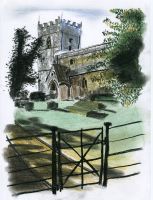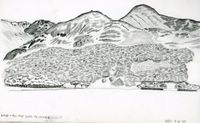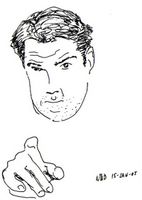It's been a while since I posted anything from my Moleskine. In fact it's been a while since I posted anything at all; I've never been the most prolific sketcher in the world. So here's four in one post for you, all recent entries into my Moleskine.

First up, a pen sketch of my wine glass that I did quickly a couple of weeks ago as it sat on the coffee table. There were some interesting reflections in the glass, and I wondered how easy it would be to capture them quickly. Umm, it wasn't.
Anyway, as a little extra, there's also a bad joke for you to groan at (though you may have to click the picture to see the larger version in order to be able to read it). If anyone from the UK is in the middle of putting on a pantomime at the moment, you can have that one on me! (As I understand it, most people from outside the UK have yet to discover the joys of a good pantomime at Christmas ...)
You might notice the pointer from the joke back to another page. Yes, I have more of these! I tend to write them down as I hear them. They're never original -- pantomime jokes should never be original.

Next is a doodle which, strictly speaking, isn't a Moleskine doodle: I just stuck it into my Moleskine because I kind of liked the shading, and the way the shadows in the guy's face blended into the random bits of shading. As the note in the Moleskine says (if you can be bothered to read it), this was really the result of me scribbling to try and get my Pilot mini gel pen working again. I carry it around with my Hipster PDA (I hate that term) in my back pocket, and it tends to get full of fluff. Bonus points if you can identify the words that I've scribbled over ;-)
If you like sketches with beautiful shading, by the way, you should check out the
sketches Mike Rohde has posted on his
blog. He does this sort of thing so much better than me. Hey Mike, if you're reading this, it's a long time since you posted any sketches!

Now this strange looking thing is actually more true-to-life than you might first think. My wife (who, you might remember, is studying for an Applied Arts degree), made this fantastic wire sculpture a few days ago based on her hand. She can't make up her mind what to do with it, though I think she's currently thinking in terms of "skinning" it using the stuff you use to make plaster casts. Anyway, there's this fantastic bare wire hand sitting on the coffee table. I thought "hey, that's all one piece of wire, I could draw that with one continuous line", so I did. While I was doing this, I found myself thinking about the differences in the way my 2D sketch was composed, versus her far more complicated 3D "sketch". In particular, it mattered far less to me what order I drew each part, whereas for her sculpture it was absolutely crucial. And I could take shortcuts: the springy spirals around the base were just drawn over the top of the line representing the stand, for example, whereas she had to spend a lot of time curling wire round and round the base, creating the spring ... All a bit obvious, perhaps, but interesting to think about these sorts of differences.

And finally, a lesson on when to leave well alone. I was chatting to my girls a few evenings ago, and there was a ballpoint and some paper on the table in front of me, so I started to doodle while they told me about their day. It started off as a sketch of my youngest's hand, but, as usual, she never keeps still enough. The hand ended up looking cupped, and though I didn't particularly like it, it put me in mind of someone shouting. So that's what I ended up doodling -- a shouting man. I didn't like the hands, but I did quite like his comic-book face, and the mouth in particular. Yup, that's a keeper, so I'll stick it in the Moleskine.
And there I should have left it. But no, I decided it would be nice to repeat the exercise in the Moleskine itself, but in black ink this time. Like the doodle, I was looking for something quick and instinctive, but I ended up with something that was just rubbish. I started with the hand again (why?), and it didn't even look like a hand. Then I started on the face, and he just ended up looking scared. At this point, I gave up, annoyed with myself for not stopping with the original doodle.
 Father Christmas brought me a lovely, tiny sketchbook, four inches square. I was watching a program about Tony Hancock on television last night, and it struck me what a wonderful sketchable face he had -- gentle and full of expression. I haven't yet perfected the art of either sketching from life, or sketching from memory (hi Doug), but as luck would have it, the Radio Times had published an old photo of him to advertise the program. So this has become the first sketch in my new sketchbook.
Father Christmas brought me a lovely, tiny sketchbook, four inches square. I was watching a program about Tony Hancock on television last night, and it struck me what a wonderful sketchable face he had -- gentle and full of expression. I haven't yet perfected the art of either sketching from life, or sketching from memory (hi Doug), but as luck would have it, the Radio Times had published an old photo of him to advertise the program. So this has become the first sketch in my new sketchbook.












































